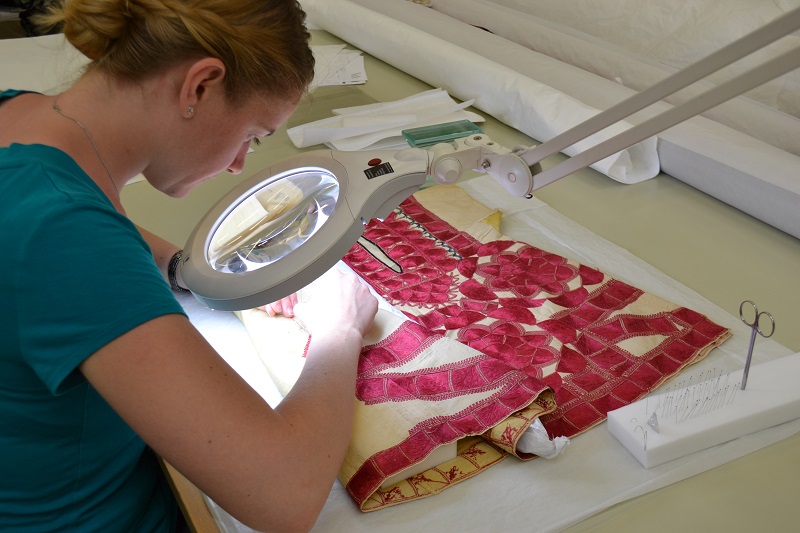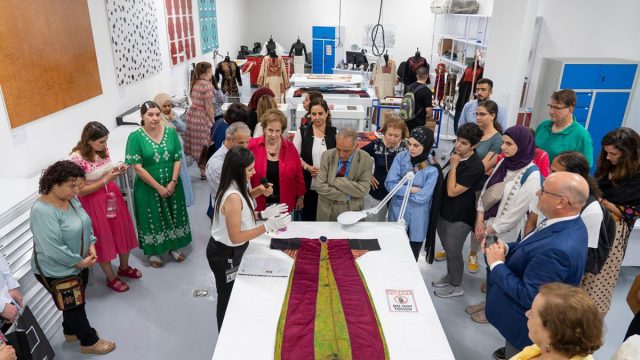Annika Amundson is a student placement in the V&A Textile Conservation Studio, a part of her MPhil course at the Centre for Textile Conservation, University of Glasgow. This week she tells us about the conservation of an embroidered child’s dress in preparation for its display in The Fabric of India.
This child’s dress will be displayed in the techniques section of the exhibition as an example of Indian embroidery techniques, showing the differences between regional designs as well as between professional and home-made pieces.
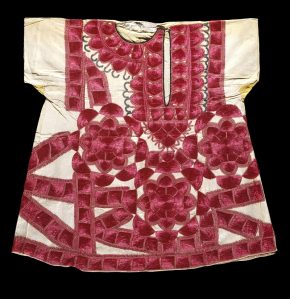
The primary concern regarding the conservation of the dress is the creasing that has resulted from folded storage, which is both unsightly and damaging to the fabric. In many places the creases had weakened the cloth so far as to create splits and holes. After the creases are removed, these areas of damage will be stabilized to prevent them deteriorating further.
Removing creases from fragile textiles is a slow and gentle process. Essentially, the goal is to reintroduce just enough moisture to the fibres of the fabric to give them more flexibility and then to keep the area flat, usually under light weights, while it dries out again. Depending on the material, the ambient humidity, and the extent of the creases, the process can take anywhere from an afternoon to several months! You can see in the photo below the process of arranging the dress to place the creases on a flat surface, and then evenly weighed down by the glass weights to smooth out the folds.
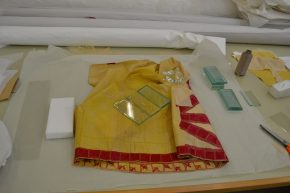
With the creases reduced, I could turn my attention to the holes that had developed along the lines of creasing. These I supported with silk that I had dyed to match the colour of the silk of the garment. There are two different shades of patch material: one a yellow to match the back of the dress and the other a lighter cream to match the front where the yellow has faded away. The silk patches are stitched into place around the areas of damage, where the fabric is still strong. Then the edges of the holes are lightly attached to the support patch using couching, a stitching technique that involves ‘laying’ a thread across the area of damage and holding it down with smaller stitches along the laid thread. This technique allows the patched area the flexibility to drape while reducing the strain on the original fabric while it is handled and mounted for display.
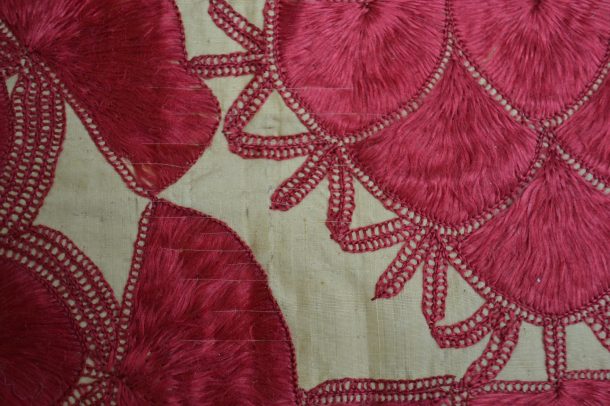
The thread choice for the support of the damaged areas is very important, as it needs to fulfil several potentially conflicting needs. It must be strong enough to support, be small and unobtrusive, and be made of a material that will not react with or damage the object it’s intended to protect. For this situation, I chose threads drawn from Stabiltex®, an extremely fine polyester thread that is stronger than silk of the same size and will last longer under display conditions. This is a commonly used conservation thread that fulfils the three requirements stated above. The thread is so fine that I needed extra magnification to see what I was stitching.
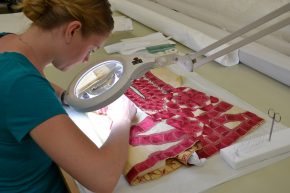
The dress will be displayed hanging up and flat on a hidden Perspex hanger, so in addition to supporting the areas already damaged, I wanted to prevent damage that may occur as a result of the display conditions. This included putting two large patches across the inside of the shoulders, to reinforce the area where most of the hanging weight will be held, and making a copy of the shape of the garment in a stiffer fabric to hang between the dress and its hanger. The stiffer copy creates an internal structure for the dress, further distributing the hanging weight away from the shoulders. Below you can see the internal structure, shaped to be invisible while on display, and our test hang to make sure the internal support is fulfilling its mission. To see the ‘after’ picture, come and visit the exhibition when it opens October 3rd!
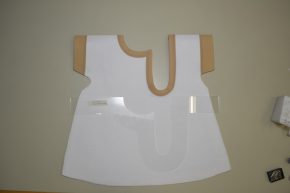
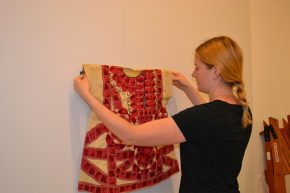
The goal of the student placement is to apply the skills we gain during the school year. (You can learn more about textile conservation education at the Centre for Textile Conservation’s academic blog.) During my placement I’ve primarily worked on preparing objects for display, including mannequin padding for a contemporary sari, creating a roller mount for a flat textile, and a last minute support mount for an incoming loan of a pair of shoes to be installed in Shoes: Pleasure and Pain which is now open. I’ve also helped out with current exhibitions, dusting objects on open display in the Alexander McQueen exhibition, Savage Beauty. I think the biggest lesson I’ve learned during my placement is that conservation is never finished, but is an ongoing process balancing the needs of the objects, the possibility of research, and the goals of exhibition and public access.
It’s been an incredibly exciting experience to work with the textile conservation team preparing so many amazing objects for what promises to be a beautiful exhibition. I’d like to take this opportunity to thank the V&A textile conservation studio for hosting my student placement. And next time you visit one the textile displays, lean in to see if you can find the evidence of conservation in action!
